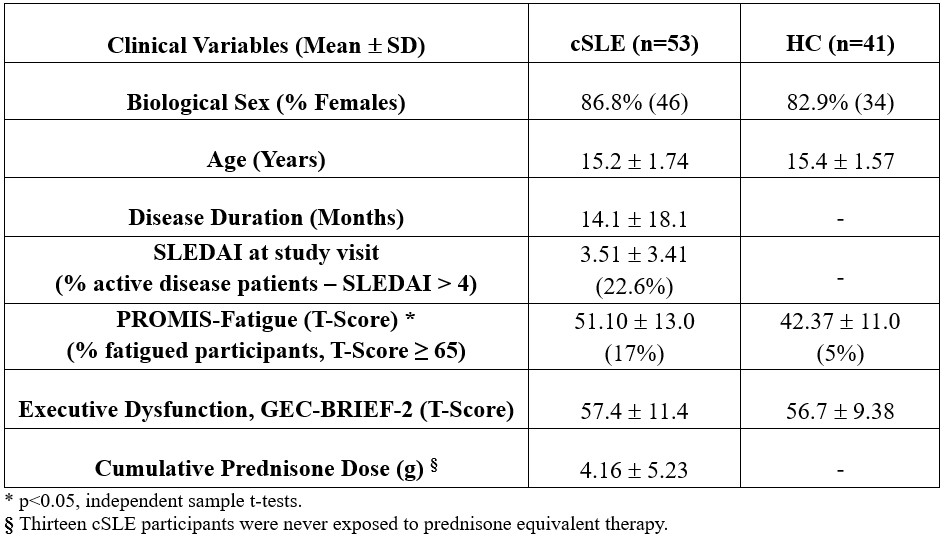Session Information
Session Type: Poster Session B
Session Time: 10:30AM-12:30PM
Background/Purpose: Fatigue and brain fog are early complaints in adolescents with childhood-onset SLE (cSLE), who experience disease onset during a critical period of brain development. The typical neurodevelopmental process of folding or ‘gyrification’ of the cerebral cortex peaks during toddlerhood and decreases across puberty. Cortical folding patterns, as measured by the local gyrification index (LGI), may be altered in neurological disorders with childhood onset, such as autism, and related to neurodevelopmental pathology and cognitive and behavioral impairments, including executive dysfunction, fatigue, and depression. However, this metric has not yet been evaluated in cSLE cohorts. We aimed to (i) evaluate differences in LGI between adolescents with cSLE and healthy peers; and (ii) examine the relationship between LGI and fatigue while controlling for executive function.
Methods: T1-weighted MRI was cross-sectionally acquired at 3T from 53 youth with cSLE according to the ACR, SLICC or EULAR classification criteria, and 41 age/sex-matched healthy controls (HC) aged 11-17 years. Fatigue and executive dysfunction were self-reported from the Patient Reported Outcomes Measurement Information System (PROMIS) and the Behavior Rating Inventory of Executive Function (BRIEF-2, Global Executive Composite – GEC) assessment. LGI between-group differences across the whole brain cortex were calculated in Freesurfer with vertex-wise General Linear Models, controlling for age, sex, and surface area. Associations between LGI and fatigue were evaluated with regression analyses adjusted for age, education level, and GEC scores. Family-wise corrections for multiple comparisons were performed with permutation testing (10,000 permutations; p< 0.05, two-tailed).
Results: cSLE and HC groups displayed comparable age/sex distributions and GEC scores. When compared to controls, participants with cSLE exhibited higher fatigue (Table 1); and fatigue correlated with higher executive dysfunction in both cohorts (r=0.39-0.45, p< 0.01). Group analyses revealed higher LGI in 26 clusters spanning widespread bilateral regions of the frontal (clusters A and B) and temporal (cluster C) cortices in adolescents with cSLE when compared to HC (Fig. 1). For both groups, higher fatigue associated with lower LGI in clusters partially overlapping central/inferior frontal regions (Fig. 2). For lateral occipital regions, higher fatigue correlated with lower LGI in cSLE, while the inverse association (higher LGI) was observed in the HC group (Fig. 2).
Conclusion: Patients with cSLE exhibited higher fatigue levels and increased gyrification in frontotemporal regions compared to HC, suggesting atypical morphological brain development. Both cSLE and control groups showed shared relationships between fatigue and LGI in frontotemporal regions, and distinct relationships in occipital regions after adjusting for executive function. Given the neurophysiological links to mental fatigue in these regions, further longitudinal studies are needed to determine if abnormal gyrification is an early compensatory mechanism in response to SLE pathology or a driver of fatigue.
To cite this abstract in AMA style:
Valdes Cabrera D, El Tal T, Arciniegas S, Mwizerwa O, Jeyanathan A, Ng L, Moaf P, Law J, Mossad S, Ertl-Wagner B, Yeh A, Branson H, Davis A, Hiraki L, Levy D, Zapparoli B, Danguecan A, Knight A. Abnormal Cortical Gyrification Patterns in Adolescents with Childhood-onset SLE: Early Associations with Perceived Fatigue [abstract]. Arthritis Rheumatol. 2024; 76 (suppl 9). https://acrabstracts.org/abstract/abnormal-cortical-gyrification-patterns-in-adolescents-with-childhood-onset-sle-early-associations-with-perceived-fatigue/. Accessed .« Back to ACR Convergence 2024
ACR Meeting Abstracts - https://acrabstracts.org/abstract/abnormal-cortical-gyrification-patterns-in-adolescents-with-childhood-onset-sle-early-associations-with-perceived-fatigue/



